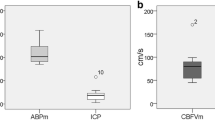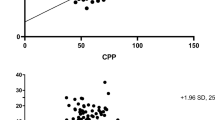Abstract
Objective: Cerebral critical closing pressure (CrCP) is the arterial pressure (AP) below which small arterial cerebral vessels collapse. Our objective was to estimate cerebral CrCP in 12 severe TBI patients, relating transcranial Doppler flow velocity (FV) and AP data. Methods: FV, intracranial pressure (ICP) and invasive AP were prospectively acquired at 50 Hz. CrCP was estimated using three methods (M): M1: amplitude ratio of FV/AP first harmonics; M2: AP axis intersection of the regression line between systolic and diastolic values of FV and AP; M3: AP axis intersection of the regression line between decreasing AP and FV simultaneous values.
Results: There were 12 patients. Frequent negative CrCP values were found. Average M1:−12 mmHg; M2:−33 mmHg; M3:−43 mmHg. Correlation between the three methods was significant (P < 0.01). M1 showed the lowest range and more positive values. The better limits of agreement (Bland and Altman test) were between M2 and M3.
Conclusions: The frequently found negative values do not allow us for the moment, to use any of these three methods for clinical guidance.
Access this chapter
Tax calculation will be finalised at checkout
Purchases are for personal use only
Similar content being viewed by others
References
López-Magaña JA, Richards HK, Radolovich DK, Kim DJ, Smielewski P, Kirkpatrick PJ, Pickard JD, Czosnyka M (2009) Critical closing pressure: comparison of three methods. J Cereb Blood Flow Metab 29:987–993
Panerai RB (2003) The critical closing pressure of the cerebral circulation. Med Eng Phys 25:621–632
Edouard AR, Vanhille E, Le Moigno S, Benhamou D, Mazoit JX (2005) Non-invasive assessment of cerebral perfusion pressure in brain injured patients with moderate intracranial hypertension. Br J Anaesth 94:216–221
Burton AC (1951) On the physical equilibrium of small brain vessels. Am J Physiol 164:319–329
Dewey RC, Pieper HP, Hunt WE (1974) Experimental cerebral hemodynamics. Vasomotor tone, critical closing pressure, and vascular bed resistance. J Neurosurg 41:597–606
Thees C, Scholz M, Schaller MDC, Gass A, Pavlidis C, Weyland A, Hoeft A (2002) Relationship between intracranial pressure and critical closing pressure in patients with neurotrauma. Anesthesiology 96:595–599
Biestro AA, Alberti RA, Soca A, Cancela M, Puppo CB, Borovich B (1995) Use of indomethacin in brain-injured patients with cerebral perfusion pressure impairment: preliminary report. J Neurosurg 83:627–630
Aaslid R, Lash SR, Bardy GH, Gild WH, Newell DW (2003) Dynamic pressure-flow relationships in the human cerebral circulation. Stroke 34:1645–1649
O’Rourke MF, Nichols WW (1988) Mc Donalds Blood flow in arteries: theoretical, experimental and clinical principles. Arnold, London, pp 187–190
Dawson SL, Panerai RB, Potter JF (1999) Critical closing pressure explains cerebral hemodynamics during the Valsalva maneuver. J Appl Physiol 86:675–680
Aaslid R (1992) Cerebral hemodynamics. In: Newell DW, Aaslid R (eds) Transcranial Doppler. Raven, New York, pp 49–55
Czosnyka M, Smielewski P, Piechnik S, Al-Rawi PG, Kirkpatrick PJ, Matta BF, Pickard JD (1999) Critical closing pressure in cerebrovascular circulation. J Neurol Neurosurg Psychiatry 66:606–611
Gazzoli P, Frigerio M, De Peri E, Rasulo F, Gasparotti R, Lavinio A, Latronico N (2006) A case of negative critical closing pressure. Abstracts of the 8th International Conference on Xenon CT and related Cerebral Blood Flow Techniques: cerebral blood flow and brain metabolic imaging in clinical practice. British Journal of Neurosurgery 20:348
Panerai RB, White RP, Markus HS, Evans DH (1998) Grading of cerebral dynamic autoregulation from spontaneous fluctuations in arterial blood pressure. Stroke 29:2341–2346
Conflict of interest statement
We declare that we have no conflict of interest.
Author information
Authors and Affiliations
Corresponding author
Editor information
Editors and Affiliations
Rights and permissions
Copyright information
© 2012 Springer-Verlag/Wien
About this chapter
Cite this chapter
Puppo, C., Camacho, J., Yelicich, B., Moraes, L., Biestro, A., Gomez, H. (2012). Bedside Study of Cerebral Critical Closing Pressure in Patients with Severe Traumatic Brain Injury: A Transcranial Doppler Study. In: Schuhmann, M., Czosnyka, M. (eds) Intracranial Pressure and Brain Monitoring XIV. Acta Neurochirurgica Supplementum, vol 114. Springer, Vienna. https://doi.org/10.1007/978-3-7091-0956-4_55
Download citation
DOI: https://doi.org/10.1007/978-3-7091-0956-4_55
Published:
Publisher Name: Springer, Vienna
Print ISBN: 978-3-7091-0955-7
Online ISBN: 978-3-7091-0956-4
eBook Packages: MedicineMedicine (R0)




